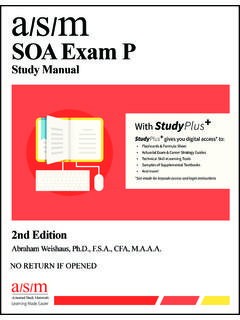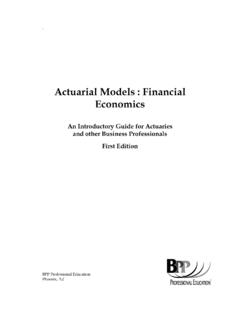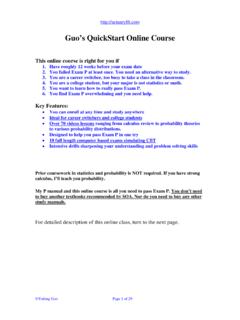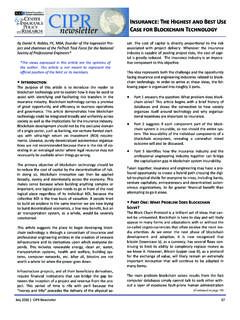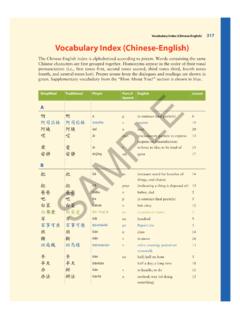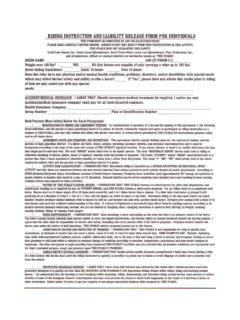Transcription of SOA Exam IFM - actuarialbookstore.com
1 Actuarial Study MaterialsLearning Made EasierWith StudyPlus+1st EditionAbraham Weishaus, , , , NO RETURN IF OPENEDS OA Exam IFMS tudy ManualStudyPlus+ gives you digital access* to: Actuarial Exam & Career Strategy Guides Technical Skill eLearning Tools Samples of Supplemental Textbook And more!*See inside for keycode access and login instructionsContents1 Introduction to Derivatives1 Exercises ..3 Solutions ..42 Project NPV .. Project analysis .. Break-even analysis .. Sensitivity analysis .. Scenario analysis .. Risk measures .. Four risk measures .. Coherent risk measures .. 10 Exercises .. 11 Solutions .. 143 Monte Carlo Simulation19 Exercises .. 23 Solutions .. 394 Efficient Markets Hypothesis (EMH)53 Exercises .. 56 Solutions .. 575 Mean-Variance Portfolio Theory59 Exercises .. 68 Solutions .. 726 Capital Asset Pricing Model (CAPM) Required return .. CAPM .. 78 Exercises .. 81 Solutions.
2 857 Cost of Estimating CAPM s parameters .. Project cost of capital .. 90 Exercises .. 92 Solutions .. 988 Behavioral Finance and Multifactor Behavioral finance .. Multifactor models .. 104 Exercises .. 106 Solutions .. 1079 Capital Structure109 Exercises .. 112 IFM Study Manual 1steditionCopyright 2018 ASMiiiivCONTENTSS olutions .. 11510 The Effect of Taxes on Capital Structure119 Exercises .. 121 Solutions .. 12311 Other Factors Affecting Optimal Debt-Equity Bankruptcy and Financial Distress .. Agency costs and benefits .. Asymmetric information .. 130 Exercises .. 131 Solutions .. 13512 Equity Sources of capital for private companies .. Allocation of company value among investors .. Going public: the IPO .. IPO puzzles .. 142 Exercises .. 143 Solutions .. 14513 Debt Corporate Debt .. Other Debt .. 148 Exercises .. 149 Solutions .. 15014 How a forward works.
3 Pricing a Forward .. Additional Comments on Forwards .. Forward Premium .. Comparison of Forward Price to Expected Future Price .. Synthetic forwards .. 156 Exercises .. 157 Solutions .. 16115 Variations on the Forward Prepaid forwards .. Futures .. 166 Exercises .. 167 Solutions .. 17016 Call options .. Put options .. 175 Exercises .. 176 Solutions .. 18117 Option Options with Underlying Assets .. Synthetic Forwards .. 187 IFM Study Manual 1steditionCopyright 2018 Bear Spreads, Bull Spreads, and Collars .. Spreads: buying an option and selling another option of the same kind .. Collars: buying one option and selling an option of the other kind .. Straddles, Strangles, and Butterfly Spreads .. 193 Exercises .. 196 Solutions .. 20618 Put-Call Stock put-call parity .. Synthetic stocks and Treasuries .. Synthetic options .. Currency options .. 215 Exercises.
4 217 Solutions .. 22419 Comparing Bounds for Option Prices .. Early exercise of American options .. Time to expiry .. Different strike prices .. Three inequalities .. Options in the money .. 250 Exercises .. 251 Solutions .. 25320 Binomial Trees Stock, One Risk-neutral pricing .. Replicating portfolio .. Volatility .. 265 Exercises .. 268 Solutions .. 27621 Binomial Trees Multi-period binomial trees .. American options .. Currency options .. Futures .. Other assets .. 294 Exercises .. 295 Solutions .. 30422 Binomial Trees: Understanding Early Exercise of Options319 Exercises .. 320 Solutions .. 32123 Modeling Stock Prices with the Lognormal The normal and lognormal distributions .. The normal distribution .. The lognormal distribution .. Jensen s inequality .. The lognormal distribution as a model for stock prices .. Stocks without dividends .. 326 IFM Study Manual 1steditionCopyright 2018 Stocks with dividends.
5 Prediction intervals .. Conditional payoffs using the lognormal model .. 330 Exercises .. 336 Solutions .. 33824 The Black-Scholes Black-Scholes Formula for common stock options .. Black-Scholes formula for currency options .. Black-Scholes formula for options on futures .. 350 Exercises .. 351 Solutions .. 35725 The Black-Scholes Formula: Greeks .. Delta .. Gamma .. Vega .. Theta .. Rho .. Psi .. Greek measures for portfolios .. Elasticity and related concepts .. Elasticity .. Related concepts .. Elasticity of a portfolio .. What will I be tested on? .. 391 Exercises .. 391 Solutions .. 39826 Delta Overnight profit on a delta-hedged portfolio .. The delta-gamma-theta approximation .. Hedging multiple Greeks .. What will I be tested on? .. 415 Exercises .. 416 Solutions .. 42427 Asian, Barrier, and Compound Asian options .. Barrier options.
6 Maxima and minima .. Compound options .. Compound option parity .. 443 Exercises .. 444 Solutions .. 45128 Gap, Exchange, and Other Gap options .. Definition of gap options .. Pricing gap options using Black-Scholes .. Delta hedging gap options .. 463 IFM Study Manual 1steditionCopyright 2018 Exchange options .. Other exotic options .. Chooser options .. Forward start options .. 467 Exercises .. 469 Solutions .. 47829 Supplementary Questions Derivatives487 Solutions .. 49530 Real Decision trees .. Black-Scholes .. Option to abandon project .. 508 Exercises .. 509 Solutions .. 51131 Actuarial Applications of Variable annuities .. Mortgage guaranty insurance .. Other insurance features that constitute options .. Static hedging strategies using exotic options .. Dynamic hedging .. Hedging catastrophe risk .. 519 Exercises .. 520 Solutions .. 522 Practice Exams5251 Practice Exam 15272 Practice Exam 25373 Practice Exam 35474 Practice Exam 45575 Practice Exam 55676 Practice Exam 65757 Practice Exam 75838 Practice Exam 85919 Practice Exam 959910 Practice Exam 1060711 Practice Exam 11617 IFM Study Manual 1steditionCopyright 2018 ASMviiiCONTENTSA ppendices627A Solutions to Old Solutions to SOA Exam MFE, Spring 2007.
7 Solutions to CAS Exam 3, Spring 2007 .. Solutions to CAS Exam 3, Fall 2007 .. Solutions to Exam MFE/3F, Spring 2009 .. Solutions to Advanced Derivatives Sample Questions .. 643B Lessons Corresponding to Questions on Released and Practice Exams655C Standard Normal Distribution Function Table659 IFM Study Manual 1steditionCopyright 2018 ASML esson 2 Project AnalysisReading:Corporate , IFM 21-18 2 3 This lesson begins the corporate finance part of the course. From here up to and including lesson 13,when not told otherwise, assume that interest rates are annual NPVWhen a company considers embarking on a project, it must verify that this project will meet the company sfinancial goals. The measure we will use for this isNPV, or net present value. To compute the NPV wecalculate thefree cash flowsof the project. The free cash flows are the cash amounts generated by theproject itself, both positive and negative, year by year. Cash flows do not include non-cash accountingitems, such as free cash flows also do not include cash flows from financing used tosupport the project.
8 If a loan is taken to pay the project s initial expenses, neither the loan nor interest onthe loan is part of free cash flows. Free cash flows are purely cash generated by the project NPV is the present value, at the start of the project, of the project s free cash flows. At whatinterest rate is the NPV calculated? Usually the NPV is calculated at the interest rate the company mustpay to finance the project. In other words, the NPV is calculated at the interest rate that has to be paid toinvestors in order to get them to invest in the project. This interest rate is called thecost of capital. We willdiscuss what the cost of capital should be in the following life insurance company is considering developing a new Universal Life product. It willcost $5 million, payable immediately, to develop this product, and developing the product will take ayear. The company estimates free cash flows will be $ 1million at the end of the first year, followed by$1 million per year for 5 years, and will then decrease at a compounded rate of 10% per year after company s cost of capital is 12%.
9 Calculate the NPV of the :The NPV generated during the first 6 years is 5,0000,000 1,000, +1,000,000( ) 5,797,194+1,000,000(1 1 ( )) 2,674,307 After 6 years, free cash flows form a geometric series with first term900,000 TheNPV generated after year 6, in millions, is9000,000(1 ) 2,072,582 Total NPV is 2,674,307+2,027,582 601,725. Companies should invest in a project only ifNPV>0. Otherwise they destroy the value of , for insurance products, they include changes in reserves. A company must set aside cash to support the reserves,although this cash may be Study Manual 1steditionCopyright 2018 ASM562. PROJECT ANALYSISIf we assume that free cash flows are constant, they form a perpetuity. As you learned in FinancialMathematics, the present value at of an immediate perpetuity of 1 per year is1/i, whereiis the interestrate. If the free cash flows are 1 in the first year and grow at compounded rateg, then their present valueisNPV n 1(1+g)n 1(1+i)n 1/(1+i)1 (1+g)/(1+i) 1/(1+i)(i g)/(1+i) 1i g( )?
10 Quiz 2-1A company is considering a project. This project will require an investment of 10 millionimmediately and will generate free cash flows of 1 million per year at the end of one year, increasing at acompounded rate of 3% per year cost of capital is 9%.Calculate the NPV of the Project Break-even analysisCompanies analyze the risk in a project. One way to analyze the risk is to vary the assumptions used tocalculate the NPV with the changed analysisconsists of determining the value ofeach assumption parameter for which the NPV is 0, assuming that the other assumption parameters areat their baseline ofIRRis an example of break-even analysis. IRR, the internal rate of return, is an alternativeprofit measure to NPV. The IRR is the interest ratersuch that the present value of free cash flows atris the usual pattern of negative free cash flows initially followed by positive free cash flows, IRRis the highest interest rate for which the NPV is at least 0.


